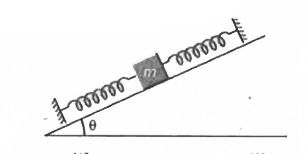If k is the force constant of the spring and μ is the coefficient of friction between the body of mass m and the floor, then write the total negative work done on the body tied to a spring at one end and the other end of the spring to a rigid support. Solution in Kannada
Negative work done = 12kx2+μmgxm.
Topper's Solved these Questions
- WORK, POWER AND ENERGY BOOK - SUBHASH PUBLICATIONCHAPTER - WORK, POWER AND ENERGY EXERCISE - TWO MARKS QUESTIONS AND ANSWERS
15 Videos
- WORK, POWER AND ENERGY BOOK - SUBHASH PUBLICATIONCHAPTER - WORK, POWER AND ENERGY EXERCISE - THREE MARKS QUESTIONS AND ANSWERS
6 Videos
- WAVESBOOK - SUBHASH PUBLICATIONCHAPTER - WAVESEXERCISE - NUMERICALS WITH SOLUTIONS
46 Videos
Similar Questions
Deduce the work-energy theorem for a constant force.
View SolutionShow that the displacement in time t is proportional to t32 under the influence of a constant power.
View SolutionA string of mass 2.50kg is under a tension of 200N.The length of the stretched string is 20.0 m. If a transverse jerk is struck at one end of the string, how long does the disturbance take to reach the other end ?
View SolutionA block of mass m is attached to one end of a mass less spring of spring constant k. the other end of spring is fixed to a wall the block can move on a horizontal rough surface. The coefficient of friction between the block and the surface is mu then the compession of the spring for which maximum extension of the spring becomes half of maximum compression is .
View SolutionOn a smooth inclined plane a body of mass M is attached between two springs. The other ends of the spring are fixed to ffirm supports. If each spring has a force constant k, the period of oscillation of the body is: (assuming the spring as massless)
View SolutionOn a smooth inclined plane, a body of mass M is attached between two springs. The other ends of the springs are fixed to firm supports. If each spring has force constant K , the period of oscillation of the body (assuming the springs as massless) is
View SolutionOn a smooth inclined plane a body of mass M is attached between two springs. The other ends of the springs are fixed to firm supports. If each spring has a force constant k, the period of oscilation of the body is (assuming the spring as massless)
View SolutionA spring of spring constant 'k' is supported from one end and tied by a mass 'm' at the other end. Write the formula to find the period of oscillation of the mass body. (Ignore the mass of the spring).
View SolutionThe force of two springs is constant k ,. One end of a spring is connected to the other end. The equivalent force of the combined spring system is constant a (k + kg),
View Solutionएक चिकने आनत तल पर m द्रव्यमान का एक पिण्ड दो स्प्रिंगों के बीच बँधा है। आधार को दृढ़ करने के लिए स्प्रिंग के दूसरे सिरे कसे गये है। यदि प्रत्येक स्प्रिंग का बल नियतांक k है, पिण्ड का दोलकाल है
(स्प्रिंगों को द्रव्यमान रहित मानने पर)

View SolutionOn a smooth inclined plane, a body of mass M is attached between two springs. The other ends of the springs are fixed to firm supports. If each spring has force constant K, the period of oscillation of the body (assuming the springs as massless) is :
View SolutionA body of M mass is tied at the lower end of a vertical spring. The spring hangs from a roof and its value of force is k. When the body was released, it was in a break state and the spring was stretchless. The maximum length of the spring will increase
View SolutionA spring with one end attached to a mass and the other to a rigid support is stretched and released.
View SolutionOn a smooth inclined plane a body of mass M is attached between two springs. The other ends of the springs ar fixed to firm supports. If each spring has a force constant k, find the period of oscillation of the body.
View SolutionOn a smooth inclined plane a body of mass M is attached between two springs. The other ends of the springs ar fixed to firm supports. If each spring has a force constant k, find the period of oscillation of the body.
View Solution
